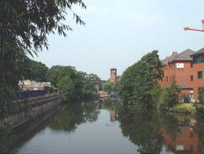-this document obtained and transcribed by Paul Tunaley |
||||||||||||
b. Derby abt. 1743. m. Catherine Hefferd, 11-6-1764. With regard to Thomas's death, a record has been found by J.H. of a "Thomas Tunnely buried 9 Dec 1781" at "St. Werburges In Derby." Along with other circumstantial evidence there is a strong possibility this is Thomas Tunaley the throwster. N.B. No children born to Thomas/Catherine after 1780 and Hall and Tunaley silk throwing partnrship folded shortly after 1781
The Old Silk Mill looking down the Derwent River-click picture to enlarge.
To see how the original Old Silk Mill looked click here
The two Tunaley dyeing houses appear to have been set up at the time of the Napoleonic wars 1799-1815 when there was a blockade on trade with France. Dyeing rapidly died out in Derby and the rest of the country following the repeal of the Corn Laws, the German manufacture of synthetic dyes and the Cobden free trade agreement (around 1860). Consequent to these events, thousands of dyers were put out of work. Recovery took place in the Derby area with development of the railways (see also below) and in the form of new processes as exemplified by Stevenson's dyers of Ambergate, who became world leaders in dyeing for the next 100 years. (The Derby-Ambergate section of the Peak Railway was opened by the Midland Railway in 1840 with the line to Manchester completed in 1860 - click here).
Thomas; General Dyer (Silk and Cotton) at 5, Tenant St. Derby abt. 1800 onwards. Between 1795 and 1800 and judging by the dates of marriage and location, Thomas appears to have moved temporarily to Nottingham.
|
Thomas Tunaley Snr. and The Start of Dyeing on "The Holmes"
Thomas Tunaley Snr. (Master Dyer)
bp. December 26th, 1772, St.Werburgh's, Derby m. Elizabeth Potter, 16-10-1795, St. Peters, Nottingham. Elizabeth d. Derby, 5 November 1843, aged 72 years. Thomas d. Derby, 10 September, 1848.
In the book "The History and Directory of the Borough of Derby(Intended As A Guide To Strangers Visiting the Town)"By Stephen Glover Published 1843 the residences and occupations of eight of the various Tunaleys are given as follows: "Tunaley Edward, cabinet maker, Full Street. Tunaley William, Silk Dyer, Upper Brook Street. Tunaley Thos Snr., Silk Dyer, 4, Tenant Street. Tunaley Thos Jnr. Silk Dyer 7, Derwent Street. Tunaley Samuel, Silk Dyer 17, Derwent Row. Tunaley Henry, Silk Dyer, Tenant Street. Tunaley John, Silk Dyer, Tenant Street. Tunaley Thos Snape, Dancing Master, Full Street." (Thomas Snape Tunaley was son of Robert Tunaley d. 1820 with the Full Street property rented out by Robert's widow, Constantia).
|
b. 16-1-1742 m. Thomas Tunaley, 11-6-1764. Catherine d. Derby, Sept 24th, 1808, aged 67 years.
Click here for George Sorocold of Derby (1668-1738), "The First British Civil Engineer."
Click here for John Heathcoat and his undoubted influence on the Thomas Tunaleys with his invention and dicovery of the lace-making machine 1807.
Read here about an even more amazing character: Samuel Slater, from Belper, Derby, father of the American Industrial Revolution following apprenticeship with Jedediah Strutt at Milford, Derbys.
Later, Mary Tunaley (b. 1775) married (1805) Francis Boott nephew of Kirk Boott the founder of the American Textiles Industry who was born Derby 1750 and emigrated to America 1783. Documents show: (1) Kirk Boott was advised by William Strutt (inventor) of Belper Derbyshire on the design and setting up of cotton mills in Massachusetts. (2) He was a friend of Joseph Wright of Derby, the landscape and portrait painter.
|
||||||||||
|
||||||||||||
|

The Tunaley Family History
Click on Names to Navigate the Tree
